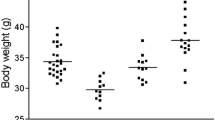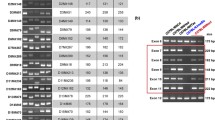Abstract
A previous genome-wide QTL study revealed many QTLs affecting postnatal body weight and growth in an intersubspecific backcross mouse population between the C57BL/6J (B6) strain and wild Mus musculus castaneus mice captured in the Philippines. Subsequently, several closely linked QTLs for body composition traits were revealed in an F2 intercross population between B6 and B6.Cg-Pbwg1, a congenic strain on the B6 genetic background carrying the growth QTL Pbwg1 on proximal chromosome 2. However, no QTL affecting body weight has been duplicated in the F2 population, except for mapping an overdominant QTL that causes heterosis of body weight. In this study, we developed 17 intersubspecific subcongenic strains with overlapping and nonoverlapping castaneus regions from the B6.Cg-Pbwg1 congenic strain in order to search for and genetically dissect QTLs affecting body weight into distinct closely linked loci. Phenotypic comparisons of several developed subcongenic strains with the B6 strain revealed that two closely linked but distinct QTLs that regulate body weight, named Pbwg1.11 and Pbwg1.12, are located on an 8.9-Mb region between D2Mit270 and D2Mit472 and on the next 3.6-Mb region between D2Mit205 and D2Mit182, respectively. Further analyses using F2 segregating populations obtained from intercrosses between B6 and each of the two selected subcongenic strains confirmed the presence of these two body weight QTLs. Pbwg1.11 had an additive effect on body weight at 6, 10, and 13 weeks of age, and its castaneus allele decreased it. In contrast, the castaneus allele at Pbwg1.12 acted in a dominant fashion and surprisingly increased body weight at 6, 10, and 13 weeks of age despite the body weight of wild castaneus mice being 60% of that of B6 mice. These findings illustrate the complex genetic nature of body weight regulation and support the importance of subcongenic mouse analysis to dissect closely linked loci.

Similar content being viewed by others
References
Abiola O, Angel JM, Avner P, Bachmanov AA, Belknap JK et al (2003) The nature and identification of quantitative trait loci: a community’s view. Nat Rev Genet 4:911–916
Barton NH, Keightley PD (2002) Understanding quantitative trait variation. Nat Rev Genet 3:11–21
Brockmann GA, Karatayli E, Haley CS, Renne U, Rottmann OJ et al (2004) QTLs for pre- and postweaning body weight and body composition in selected mice. Mamm Genome 15:593–609
Bult CJ, Eppig JT, Kadin JA, Richardson JE, Blake JA et al (2008) The Mouse Genome Database (MGD): mouse biology and model systems. Nucleic Acids Res 36:D724–D728
Christians JK, Senger LM (2007) Fine mapping dissects pleiotropic growth quantitative trait locus into linked loci. Mamm Genome 18:240–245
Christians JK, Hoeflich A, Keightley PD (2006) PAPPA2, an enzyme that cleaves an insulin-like growth-factor-binding protein, is a candidate gene for a quantitative trait locus affecting body size in mice. Genetics 173:1547–1553
Corva PM, Horvat S, Medrano JF (2001) Quantitative trait loci affecting growth in high growth (hg) mice. Mamm Genome 12:284–290
Darvasi A (1997) Interval-specific congenic strains (ISCS): an experimental design for mapping a QTL into a 1-centimorgan interval. Mamm Genome 8:163–167
Darvasi A, Soller M (1997) A simple method to calculate resolving power and confidence interval of QTL map location. Behav Genet 27:125–132
Darvasi A, Weinreb A, Minke V, Wellert JI, Soller M (1993) Detecting marker-QTL linkage and estimating QTL gene effect and map location using a saturated genetic map. Genetics 134:943–951
de Vicente MC, Tanksley SD (1993) QTL analysis of transgressive segregation in an interspecific tomato cross. Genetics 134:585–596
Dekkers JCM, Dentine MR (1991) Quantitative genetic variance associated with chromosomal markers in segregating populations. Theor Appl Genet 81:212–220
Estrada-Smith D, Castellani LW, Wong H, Wen PZ, Chui A et al (2004) Dissection of multigenic obesity traits in congenic mouse strains. Mamm Genome 15:14–22
Falconer DS, Mackay TFC (1996) Introduction to quantitative genetics, 4th edn. Longmans Green, Harlow
Farber CR, Medrano JF (2007) Fine mapping reveals sex bias in quantitative trait loci affecting growth, skeletal size and obesity-related traits on mouse chromosomes 2 and 11. Genetics 75:349–360
Farber CR, Corva PM, Medrano JF (2006) Genome-wide isolation of growth and obesity QTL using mouse speed congenic strains. BMC Genomics 7:102
Fawcett G, Jarvis J, Roseman C, Wang B, Wolf J et al (2010) Fine-mapping of obesity-related quantitative trait loci in an F9/10 advanced intercross line. Obesity 18:1383–1392
Flint J, Valdar W, Shifman S, Mott R (2005) Strategies for mapping and cloning quantitative trait genes in rodents. Nat Rev Genet 6:271–286
Fox JG, Barthold SW, Davisson MT, Newcomer CE, Quimby FW, Smith AL (2007) The Mouse in biomedical research, 2nd edn. Academic Press, San Diego
Furuse T, Takano-Shimizu T, Moriwaki K, Shiroishi T, Koide T (2002) QTL analyses of spontaneous activity by using mouse strains from Mishima battery. Mamm Genome 13:411–415
Glazier AM, Nadeau JH, Aitman TJ (2002) Finding genes that underlie complex traits. Science 298:2345–2349
Horvat S, Bunger L, Falconer VM, Mackay P, Law A et al (2000) Mapping of obesity QTLs in a cross between mouse lines divergently selected on fat content. Mamm Genome 11:2–7
Hyne V, Kearsey MJ (1995) QTL analysis: further uses of ‘marker regression’. Theor Appl Genet 91:471–476
Ishikawa A (2009) Mapping an overdominant quantitative trait locus for heterosis of body weight in mice. J Hered 100:5001–5004
Ishikawa A, Namikawa T (2004) Mapping major quantitative trait loci for postnatal growth in an intersubspecific backcross between C57BL/6J and Philippine wild mice by using principal component analysis. Genes Genet Syst 79:27–39
Ishikawa A, Matsuda Y, Namikawa T (2000) Detection of quantitative trait loci for body weight at 10 weeks from Philippine wild mice. Mamm Genome 11:824–830
Ishikawa A, Hatada S, Nagamine Y, Namikawa T (2005) Further mapping of quantitative trait loci for postnatal growth in an intersubspecific backcross of wild Mus musculus castaneus and C57BL/6J mice. Genet Res 85:127–137
Ishikawa A, Kim EH, Bolor H, Mollah MBR, Namikawa T (2007) A growth QTL (Pbwg1) region of mouse chromosome 2 contains closely linked loci affecting growth and body composition. Mamm Genome 18:229–239
Kenney-Hunt JP, Vaughn TT, Pletscher LS, Peripato A, Routman E et al (2006) Quantitative trait loci for body size components in mice. Mamm Genome 17:526–537
Kobayashi N, Toyoda T (2008) Statistical search on the Semantic Web. Bioinformatics 24:1002–1010
Leamy LJ, Pomp D, Eisen EJ, Cheverud JM (2002) Pleotrophy of quantitative trait loci for organ weights and limb bone lengths in mice. Physiol Genomics 10:21–29
Leibel RL (2008) Molecular physiology of weight regulation in mice and humans. Int J Obes 32:S98–S108
Lionikas A, Blizard DA, Gerhard GS, Vandenbergh DJ, Stout JT et al (2005) Genetic determinants of weight of fast- and slow-twitch skeletal muscle in 500-day-old mice of the C57BL/6J and DBA/2J lineage. Physiol Genomics 21:184–192
Mackay TFC, Stone EA, Ayroles JF (2009) The genetics of quantitative traits: challenges and prospects. Nat Rev Genet 10:565–577
Masinde GL, Li X, Gu W, Davidson H, Hamilton-Ulland M et al (2002) Quantitative trait loci (QTL) for lean body mass and body length in MRL/MPJ and SJL/J F2 mice. Funct Integr Genomics 2:98–104
Mehrabian M, Wen PZ, Fisler J, Davis RC, Lusis AJ (1998) Genetic loci controlling body fat, lipoprotein metabolism, and insulin levels in a multifactorial mouse model. J Clin Invest 101:2485–2496
Mizutani S, Gomi H, Hirayama I, Tetsuro I (2006) Chromosome 2 locus Nidd5 has a potent effect on adiposity in the TSOD mouse. Mamm Genome 17:375–384
Noor MAF, Cunningham AL, Larkin JC (2001) Consequences of recombination rate variation on QTL mapping studies: Simulations based on the Drosophila melanogaster genome. Genetics 159:581–588
Oliver F, Christians JK, Liu X, Rhind S, Verma V, Davison C et al (2005) Regulatory variation at glypican-3 underlines a major growth QTL in mice. PLoS Biol 3:e135
Prevoršek Z, Gorjanc G, Paigen B, Horvat S (2010) Congenic and bioinformatics analyses resolved a major-effect Fob3b QTL on mouse Chr 15 into two closely linked loci. Mamm Genome 21:172–185
Shao H, Sinasac DS, Burrage LC, Hodges CA, Supelak PJ et al (2010) Analyzing complex traits with congenic strains. Mamm Genome 21:276–286
Shockley KR, Churchill GA (2006) Gene expression analysis of mouse chromosome substitution strains. Mamm Genome 17:598–614
Stoehr JP, Byers JE, Clee SM, Lan H, Boronenkov IV et al (2004) Identification of major quantitative trait loci controlling body weight variation in ob/ob mice. Diabetes 53:245–249
Terčič D, Holcman A, Dovč P, Morrice DR, Burt DW et al (2010) Identification of chromosomal regions associated with growth and carcass traits in an F3 full sib intercross line originating from a cross of chicken lines divergently selected on body weight. Anim Genet 40:743–748
Toland E, Saad Y, Yerga-Woolwine S, Ummel S, Farms P, Ramdath R et al (2008) Closely linked non-additive blood pressure quantitative trait loci. Mamm Genome 19:209–218
Visscher PM, Haley CS (1996) Detection of putative quantitative trait loci in line crosses under infinitesimal genetic models. Theor Appl Genet 93:691–702
Wade CM, Daly MJ (2005) Genetic variation in laboratory mice. Nat Genet 37:1175–1180
Wuschke S, Dahm S, Schmidt C, Joost H-G, Al-Hasani H (2007) A meta-analysis of QTL associated with body weight and adiposity in mice. Int J Obes 31:829–841
Yang H, Bell TA, Churchill GA, Villena FPM (2007) On the subspecific origin of the laboratory mouse. Nat Genet 39:1100–1107
Yoshida Y, Makita Y, Heida N, Asano S, Matsushima A et al (2009) PosMed (Positional Medline): prioritizing genes with an artificial neural network comprising medical documents to accelerate positional cloning. Nucleic Acids Res 37:W147–W152
Yuan R, Flurkey K, Aelst-Bouma RV, Zhang W, King B, Austad S et al (2006) Altered growth characteristics of skin fibroblasts from wild-derived mice, and genetic loci regulating fibroblast clone size. Aging Cell 5:203–212
Acknowledgments
M. B. R. Mollah was supported by the Ministry of Education, Culture, Sports, Science and Technology (MEXT) Scholarship of Japanese Government. This work was supported by Grants-in-Aid for Scientific Research (B) from the Japan Society for the Promotion of Science to A. Ishikawa.
Author information
Authors and Affiliations
Corresponding author
Electronic supplementary material
Below is the link to the electronic supplementary material.
335_2011_9323_MOESM2_ESM.pdf
Supplementary Fig. 1. Construction of 17 subcongenic strains for the growth QTL Pbwg1 on mouse Chr 2. The black bar indicates the minimum genomic region derived from the M. m. castaneus mouse, and the gray bar indicates the region from the B6 mouse. The hatched bar indicates a gray zone where recombination occurred. Distal and proximal borders of each subcongenic strain are arbitrarily drawn by vertical lines. Physical map positions (Mb) of microsatellite markers are shown on the horizontal line (Supplementary Table 1). Size (Mb) indicates the minimum length of the castaneus donor region.(PDF 431 kb)
Rights and permissions
About this article
Cite this article
Mollah, M.B.R., Ishikawa, A. Intersubspecific subcongenic mouse strain analysis reveals closely linked QTLs with opposite effects on body weight. Mamm Genome 22, 282–289 (2011). https://doi.org/10.1007/s00335-011-9323-9
Received:
Accepted:
Published:
Issue Date:
DOI: https://doi.org/10.1007/s00335-011-9323-9




